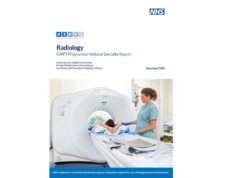
With provision of interventional radiology (IR) services varying across the UK, the Getting It Right First Time (GIRFT) programme aims to identify and reduce unwarranted variation in English trusts to help bring about improvements. GIRFT is publishing a report later this year outlining the issues that have led to this discrepancy, and providing recommendations for solutions at the local and national level. Katharine Halliday anticipates this report here, elaborating on her keynote lecture at the British Society of Interventional Radiology annual meeting (13–15 November, Manchester, UK).
Introduction to GIRFT
GIRFT is a national programme aimed at reducing unwarranted variation in the National Health Service (NHS). It began as a pilot in orthopaedic surgery, led by Professor Tim Briggs, who visited orthopaedic units across the country and led peer-to-peer discussions about the local service. The pilot was very successful, improving the standard of care for orthopaedic patients and reducing costs. The model has subsequently been rolled out to 40-plus clinical specialties, including radiology.
For each trust, a pack of comparative data is produced from national sources—this forms the basis of a discussion with clinical staff and mangers, facilitated by the clinical lead. The visit provides an opportunity for departments to showcase their good work to their executive team and for the senior managers to fully understand the vital role played by radiology in most patient pathways. The clinical lead identifies areas of good practice which can then be shared with other departments. Areas the department would like to work on are also discussed and documented.
The GIRFT radiology team has now visited almost every trust in England. The process has been a hugely educational one and we have been very impressed by the enthusiasm with which the radiology community has embraced the opportunity to review services, identify possible areas for improvement, and learn from others
Regarding interventional radiology, some strong themes have emerged:
Workforce
In 2018, the Royal College of Radiologists (RCR) identified that only one in five trusts had six interventional radiologists, considered to be the minimum number necessary to cover a comprehensive on-call service. There is no evidence that this situation is improving.
In many trusts the shortfall in the elective interventional service is mitigated by extending the role of radiographers and nurses, who now undertake many and varied interventional procedures. But radiographers and nurses are also in short supply, and some trusts are not capitalising on their training investment because staff cannot be released from image acquisition or other duties. Innovative departments have maximised the contribution of healthcare assistants to release higher banded staff for advanced practice, but over recruitment is essential for role extension to be effective.
The stimulating and varied nature of radiology nursing is not always recognised, and, on the background of a national nursing shortage, recruitment issues are keenly felt. In some cases, working with theatres has enabled a more sustainable workforce. Close liaison with other nurses from across the hospital, including students, is helpful when attracting staff. Several interventional radiology (IR) nurses have mentioned that there are few nationally-run training courses. There is an opportunity here to strengthen the nursing division of the British Society of Interventional Radiology (BSIR).
Some departments are more successful than others at recruiting and retaining their staff. A focus on training and continuing professional development proves very popular with all grades. Ideally more staff would be able to progress from the lower bands to Bands 5 and 6, but this is still challenging. GIRFT is working with national bodies to identify and reduce barriers.
Environment
We have seen wide variation in the environments for patients and staff. Those departments that operate most efficiently can admit and discharge patients from radiology, ideally with a small day case unit dedicated to imaging, overseen by nursing staff. These units are often shared with cardiology and provide a safe environment for patients and avoid expensive and frustrating delays waiting for inpatient beds. We have seen excellent radiology day case units in hospitals where there are no vascular beds which allow patients to be treated much closer to home.
Paediatrics
Paediatric intervention is particularly challenging. Although facilities and expertise in children’s hospitals are excellent, most children are seen and treated in general hospitals. Even in very small departments where most patients are adults, liaison with play therapists and the identification of a lead radiographer for paediatrics can vastly improve the experience for paediatric patients and their families. Volumes of paediatric intervention are too low to have a dedicated paediatric IR team in any but the largest specialist centres, and it is necessary for adult IR teams to develop and maintain some skills in this area.
Data
Although large quantities of radiology data are collected, the quality is often poor because there is huge local variation in the way individual procedures are coded and counted. There is also no unifying code for interventional procedures so collecting outcome data for appraisal and audit is difficult locally and impossible at a national level. GIRFT is working with a team of data experts to address these issues.
Networking
The challenges identified above result in very variable access to interventional procedures, particularly for patients presenting out of hours. The vascular surgical networks supported by the vascular surgery GIRFT work stream are maturing and continue to improve pathways for vascular patients, while many radiology departments are working together to form IR networks. The model varies depending on local circumstances and expertise but in the best departments individual pathways are identified for specific conditions and these are clearly conveyed to clinical teams. The document recently published by NHSI/E—Transforming Imaging services in England: A national Strategy for imaging networks—sets out a vision for networking in radiology which will be helpful for developing robust IR services. Strong leadership from interventional radiologists and close liaison with clinical colleagues is essential if these are to be successful.
Next steps
At the end of each GIRFT presentation the local team are asked to identify issues they would like to work on, together with good practice. These are summarised in a short report which is sent back to each trust within a couple of weeks. Local support is offered to the trust by the GIRFT implementation team who help to develop the themes and put together an action plan. Many trusts have also appointed their own GIRFT lead who will assist with local improvements. It is often possible to put departments in contact with other people who have overcome similar challenges and for good practice to be shared between institutions.
Each GIRFT work stream publishes a national report and in many of those, the essential role of radiology has been highlighted. The radiology GIRFT national report will be published in 2020. In several areas the team are already working with national bodies, but the report will highlight the issues identified across imaging departments and will make national recommendations.
Katharine Halliday is the clinical lead radiologist for the GIRFT programme and is a consultant paediatric radiologist at Nottingham University Hospitals NHS Trust, Nottingham, UK. She is past chair of the British Society of Paediatric Radiology from 2010 to 2016.













